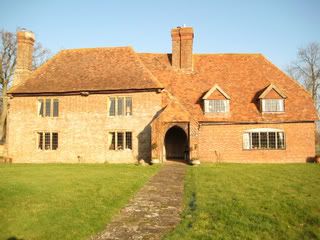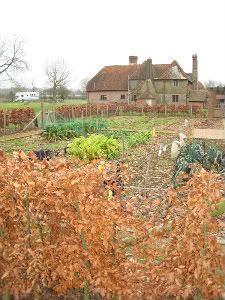Oh, I see where my remark was off, not the correct term, but I'm still excited, wish I could see pics of it! I just can't imagine - is it a stone cottage?
Sorry, didn't mean to sound as if I was correcting you, just agreeing that it was protected.
This is in Kent - the county south-east of London, south of the Thames - between London and the English Channel.
I'm sure that in some parts of the country, houses that old are indeed stone - but in Kent, the venacular architecture of the time was wood. Lots of wood in the Weald, not much stone for building. The black and white buildings you see from time to time date from the Middle Ages until Tudor times - the black parts are dried, solid oak beams, and the white bits are plaster.
My parents' house is a hall house. It was built as one large hall, more than one storey, open from the ground to the roof rafters. So the whole building was one large hall, with a fire pit in the middle of it. No chimmey when it was built, either, so the beams in the roof are blackened from medaeival smoke. There was probably a separate store room off one end of the hall, perhaps a private room for the owner's family to sleep in above it, and a kitchen separate from the hall, for fire safety.
The roof was, and is, clay tiles from local Wealden clay. There are two ponds, one at the back of the house, one at the front, which were dug out to provide clay for the tiles, and then used as handy fish ponds and for watering sheep and providing water to clean the wool. Kent was a major centre for wool and weaving from the 1300s, for centuries.
In about 1550, people decided that living, eating and sleeping in a communal hall wasn't as much fun as privacy. So they added in a floor half-way up the hall, and a staircase, and installed a central chimney, too. The first chimney seems to have been at least part wood, and when that (not surpisingly) caught fire, they built a huge brick chimney instead, roughly in the middle of the house, so there could be cooking one side, and a living room with a fireplace on the other side.
In approximately 1660, the building was re-faced in brick, to look more modern - those wooden houses were
terribly dated, sweetie, and one
simply had to have brick. In this case, a faux brick skin, rather than an actual brick house.
Then in about 1780, the last addition to the house provided another room downstairs, and two more smaller rooms upstairs.
So it's a large house, but not a manor or mansion. Downstairs is a large kitchen, a living room, sitting room, dining room, and scullery. Upstairs are sort of 6 bedrooms (sort of, because despite there being 3 staircases, one of them you can only get to by going through other bedrooms), bathrooms, and the attics.
Front of the house:
Back of the house (past the vegetable garden):
Part of the kitchen (and my son, my brother, and a dog):
Kitchen, including about half the fireplace:
Dining Room:
Main stairs and hallway:






